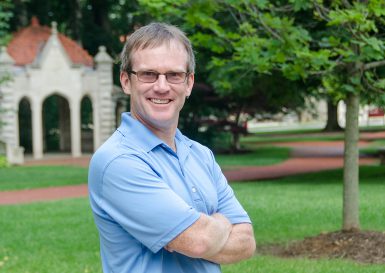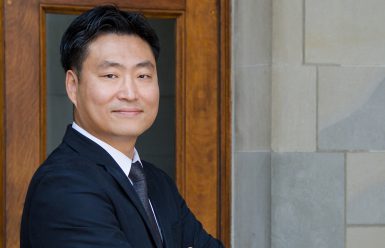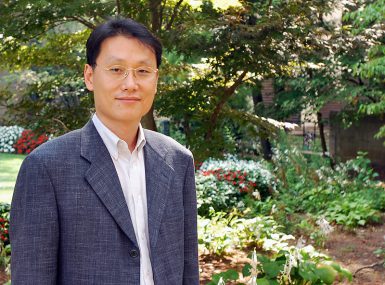Research groups aim to study, analyze, collaborate

For two Media School research groups, the mind is used in different ways.
At the Institute for Communications Research, students and faculty mine the mind and body for a deeper understanding of how people respond to media, while the Communications Research Group puts minds together to produce scholarly work.
Mining the mind and body
Student Joshua Sites needed the answer to a question: How do people respond to hearing music repetitively?
Sites’ subject sat in a chair while he was wired with monitors on his feet and arms, sensors affixed around his eyes and a headgear placed on his head.
At the Institute for Communications Research, Sites didn’t have to ask any questions; the subject’s mind and body provided the answers.
About the Institute for Communication Research
Joshua Sites, graduate student, The Media School
So right now, the participant in there is listening to music, and we’ve given him our laptop, and he’s able to do homework or Facebook or whatever he wants to do for about 40 minutes.
A college student is shown in a chair with several wires attached to him. There are close-ups of wires on his arm and foot. Joshua is shown attaching a wire to his forehead.
After that, we’re going to ask him to kind of reflect on the music that he’s heard and play parts of it to again. We’ll ask: How does this make you feel? Do you like this? And he’s hooked up to every measure in the book right now.
Rob Potter, Director, Institute for Communication Research
The data suggests that if you’re just sitting there listening to a radio station, and that radio station plays a jingle, that if you repeat those multiple times that by the end of the third or fourth repetition, it doesn’t automatically capture your attention like it does early on and like we would expect it to quite honestly.
The same test subject is shown listening to music and looking at a computer.
So what we’re looking at now is if you listen to the radio in the background while you’re studying for your media history exam coming up, do we see the same effect or when it’s in the background, do we in fact see something different, so that’s what we’re looking at now .
Joshua is typing on the research subject’s computer. He fiddles with measurements on the subject’s forehead and various measuring devices.
To me, what’s most interesting about the lab and psychophysiological measures in general is you can devise the most brilliant survey questionnaire tool ever conceived and ask people every which way: How did you feel about this or how you feel about that and and they will answer you as honestly as they can, and that data is incredibly valuable, but it doesn’t necessarily capture the whole picture.
A computer screen measuring the research subject is shown. Various levels of whatever is being measured are shown changing.
And so that’s what we’re able to do here. It helps us learn more about some deeper level processes than just what survey or questionnaires can get at.
Produced by Bronson DeLeon
The project, led by ICR director and associate professor Rob Potter, was one of many that that took place at the facility during the spring semester. Potter said the experiment followed a previous project that tested how people responded to repetitive music but didn’t allow them to do anything else during the 40-minute session, which skewed the results.
The experiment used all the equipment available: a piece of headgear that read subjects’ brain waves; sensors on the forehead and under the eyes that tracked facial muscle movements; sensors on the inside of the arms to track heartbeat; and sensors on the feet that measured arousal.
Surveys and questions can aim to gauge people’s perceptions, Sites said, but those methods have their limitations.
“It doesn’t necessarily capture the whole picture,” he said.
Sites said the software at the ICR can track the physiological activity and measure how the body and mind actually respond.
“It helps us learn more about some deeper level processes than just what survey answers can get at,” Sites said.
Potter first experienced the potential of the ICR while working on his doctorate when the facility still called Park Street home. When he came back to Indiana, the facility was readying to move to Eigenmann, and he worked with Distinguished Professor Annie Lang to redesign the ICR.
The facility has labs for measuring physiological responses and eye tracking; editing suites; content analysis systems; and software for survey design.
“We designed the space to be as flexible as it can be,” Potter said.
The ICR is open to any faculty or student and is not tied to specific projects, Potter said, and that allows researchers to explore questions about media across a wide spectrum.
Some of the projects at the ICR have examined violence on television, the content of political campaign material, the portrayal of people with mental illness in the media and how video games affect morality and decision making.
“We have just an incredible amount of different research here,” Potter said.
Sites said his research looks at mediated music, and his thesis explores the impact of generic music systems in video games. He said he’s more interested in why something works than how it works.
“This is a great place to do that,” he said.
Potter said one of the main objectives of the ICR is to encourage students and faculty to learn new research methods and collaborate.
The ICR hosts weekly meetings for students and faculty to discuss current and upcoming projects, Potter said, and people can share ideas and offer feedback. For people new to the center, he said they can find out what projects are under way and learn by watching what other faculty and students are doing.
“This is a place to learn how to do stuff that you don’t know,” Potter said.
Putting minds together

When associate professor Sung-Un Yang was a student, his advisor told him to strike a balance between his research as a sole author and collaborative work.
In the classroom, students produce their own scholarly work, but the school’s Communications Research Group fosters and environment where students and faculty work together on research projects.
“This opens a great opportunity for them to engage in such collaboration,” Yang said.
Founded in 2011, the Communications Research Group aims to create a collaborative environment for graduate students and faculty to research projects.
Associate professor Jae Kook Lee said the Communications Research Group breaks down the dynamic between faculty and students in the classroom and puts them on the same level, where they can collaborate on research projects together. He said both students and faculty pitch research ideas and work together to put together publishable papers.
“We do better in groups, a lot better than as an individual,” Lee said.
When the group first started, faculty pooled their research money to conduct a survey about social media use, Lee said, and those results became the foundation for future research. The focus on social media reflected the interest of the students and the faculty, Lee said.
One of the recent research projects explored the types of social media available and how people use them, Lee said, and what opportunities for interaction are available. He said the study looked at symmetry, which sought to see if people posted information only or wanted to interact with other users, and how that motivated people to use that type of social media.
Another project examined how social media users discuss political issues, Lee said, and whether social media created a space where people of differing political ideologies exchanged ideas or interacted with people who share their ideas.
Both of those studies were accepted for presentation at the International Communications Association’s annual conference in May.

As the Communications Research Group evolved and expanded, new research areas were incorporated. When Yang joined in 2012, he pulled together other faculty and students to start a strategic communications and public relations sub-group.
Yang said the project of the sub-group researched how consumers evaluated the credibility of organizations and products through social media. Companies and campaigns use social media to communicate with the public, Yang said, and people in turn use that medium to evaluate the efficacy of messages and that affects their attitudes.
Lee said the group’s meetings are informal, and new faculty and students can share their ideas and pitch new projects or even form a new sub-group. People need only to show up, listen and talk, he said.
When people talk with each other, it stimulates them to think in different ways, Lee said.
“We want to promote that sort of environment,” he said.

